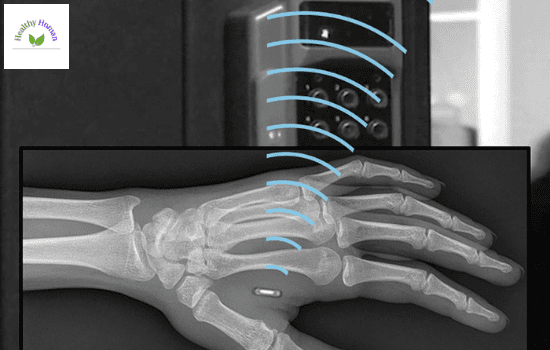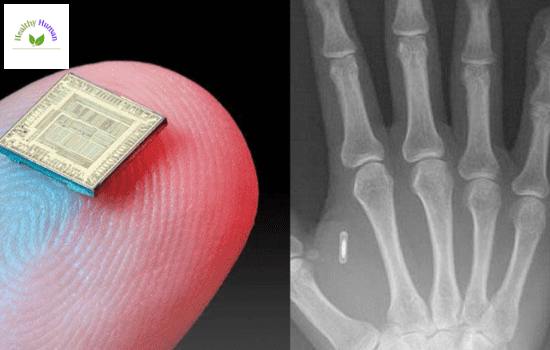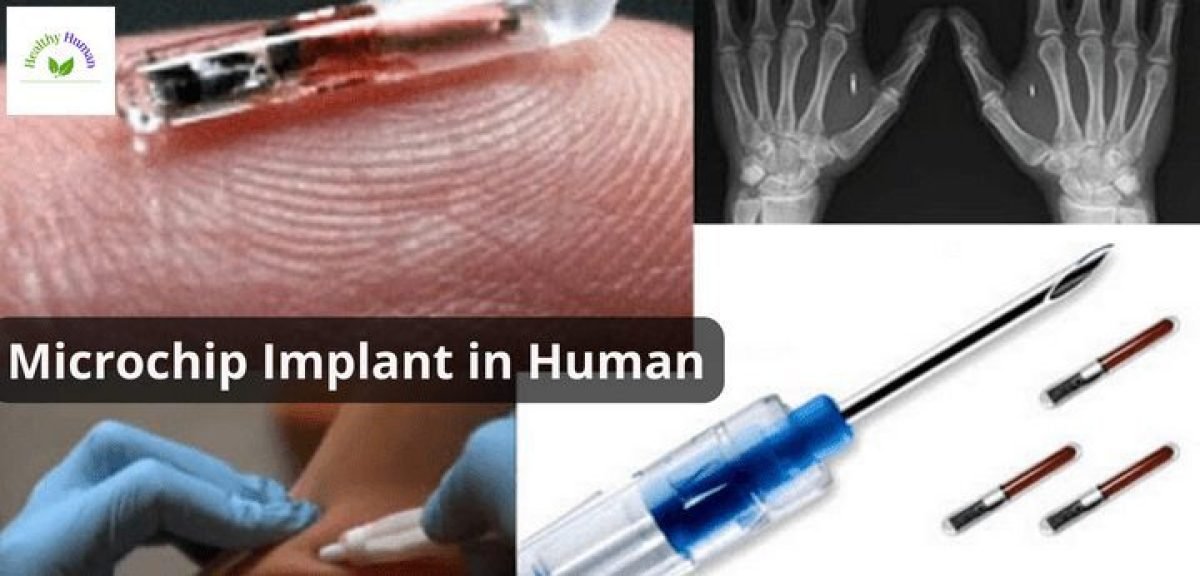Microchip implants are typically cylindrical in form. They have made out of a tiny microprocessor, a bio-safe epoxy resin. And a copper antenna wire coil that has wrapped in lead-free borosilicate glass or soda-lime Schott 8625 biocompatible glass. Animal and human microchip implants can be field powered, with no battery or power source. As a result, they are inactive until they come into contact with a reader device. With which implants interact through a magnetic field.
These implants are frequently classified as RFID (radio-frequency identification). And RFID technology spans a wide range of frequencies, devices, protocols, and interfaces. RFIDs are classified into three frequency families: low-frequency (125 and 134 kilohertz), high-frequency (13.56 megahertz), and ultrahigh-frequency (UHF) (800-915 megahertz). Implantable chips are typically either low or high frequency. Radio waves can used to identify RFID chips, while near-field communication (NFC) chips are a subset of high-frequency radio waves.
RFID technology has often used to replace keys and passwords. And making it easier to enter a home, unlock and start a car, or log in to a laptop. NFC tags, among other things, may used to hold vCards or Bitcoin wallet addresses.
The RFID microchip implants are essentially a small two-way radio the size of a grain of rice that can store digital information. The sub-dermal implant usually has a unique 16-digit identification number that may connect to information in an external database, such as personal identity, law enforcement, medical history, prescriptions, allergies, and contact information. This technology, among other things, allows for quick verification and confirmation of a person’s identification.
Benefits Of Microchip Implants

Identification
Our passports already include microchips, and switching from scanning your passport to scanning your arm would need only a minor infrastructural update. The same is true for your driver’s licence and ID: all the cops need is a chip scanner, and you can throw away your wallet (assuming you’ve previously replaced your credit/debit cards with NFC).
Memberships
The Baja Beach Club was the first to offer VIP clients microchipping. The ATM component allows you to manage and maintain food and liquor tabs. As well as simple access to membership privileges (no more lugging around a key card). Workplaces may also regulate who can go where and when eliminating the need for fobs and key cards. The same is true for libraries, gyms, hotel, and restaurant bookings, and reward card administration. And any other location where you identify yourself to get access.
No more body mix-ups
Every year, around 28,000 newborns, mixed up in hospitals and be up with the incorrect parents. On the opposite end of the scale, bodies are also occasionally mixed up in funeral homes, resulting in some unpleasant circumstances. A chip placed at birth totally eliminates the incapacity of less-capable people to identify themselves.
Infant and elder safety
It is not commonplace for elderly people to “escape” from nursing facilities. Every day, about 2,000 children abducted in the United States (amounting to over 800,000 kidnapped children per year). Every year, between 1.6 and 2.8 million kids run away from home. The ability to follow anyone at any time (with permission, of course!) promises peace of mind for millions of parents. And caregivers across the country.
Also Read:- The Reasons Behind Linking UPI With Credit Card
Child abductions
Brazilian wealthy is already implanting chips in their children to deter kidnappers, and other countries will follow suit. The first 3-4 hours after an abduction are the most significant. With almost 74% of abductions culminating in murder occurring during that time frame. According to a Future Foundation survey, 75% of British parents would buy a gadget that tracked their child’s whereabouts.
Health metadata
A simple scan may tell your doctor what you’re allergic to, what antibiotics you’ve previously been prescribed, what medications you’re now taking, and a wealth of other information that can be considered when you require medical assistance – even if you’re asleep.
Theft prevention
Using the RFID chip in your palm to pay for items, borrow books, or access doors is similar to using the RFID chip in a plastic card in your wallet. However, there is one significant difference: you may easily misplace or have your wallet taken. Body parts are far more difficult to take. Furthermore, it is far more difficult for crooks to steal your card data. When it embedded in your hand or arm, rather than a wallet in your front or rear pocket.
Criminal management
Everyone understands that prisons are not secure places. Not only does microchipping criminals render jail breakouts unnecessary, but it also increases intelligence collecting “on the inside.” Who initiated the brawl last night in the showers? Simply rewind and examine GPS intersections.
Law enforcement & gun control
Browning and Smith & Wesson have previously accepted an implant-firearm system that needs firearms to be near to their owner in order to fire. Whether your armory is taken from your house or an officer’s pistol is wrenched from their grip during a scuffle, only the registered owner will be allowed to fire it. This also prevents your children from accidentally firing the weapon they discovered on your nightstand. This also means that there will be no more “lost weapons” at crime scenes since GPS readings in weapon chips will always record where they were, when they were fired, and – obviously — by whom.
Fear Of Microchip Implants

Uncertainty
We don’t know what long-term consequences microchip implants will have on the body. And don’t know what the societal consequences of widespread chipping would be. We don’t know what complications will occur in every aspect of the concept, and we won’t know until we attempt it.
Possible health risks
Implanted microchips do not always remain in place and may move to another area, making them difficult to spot. This could be a problem in a medical situation.
Other dangers include electrical hazards, unfavorable tissue responses, infections, incompatibility with medical equipment like MRI machines, and electro-surgical and electromagnetic interference with devices like defibrillators.
Access control
Allowing firms to scan your chip for identification automatically grants them access to your location within their company.
Data leaks
Every new technology is riddled with faults and vulnerabilities. Because so much information and dependence are placed on a single chip, it becomes a great target for hackers and other bad actors. If information is written (as well as readable), there is the possibility of impersonation or data corruption.
Also Read:- Diners Club Credit Card and Benefits
Replacement hardware
This technology will undoubtedly develop with time, bringing more and more functionalities. It’s likely that these new functions will necessitate the purchase of new hardware, and that early gear may not easily replaced.
No universal standards
Unfortunately, due to the numerous digital identification schemes in use, no one card can manage them all. For the subway, you’d need an RFID chip, one for your credit card, one for your library card, and so on (or, at least, implant a rewriteable chip and store one of the above at a time).
Bodily migration
Implanted chips are susceptible to migrating throughout the body if sufficient care is not maintained. This would be less of a concern if chips were more common (since they could simply be sought for), but until then, it’s very feasible that they’d be disregarded (in medical situations, for example) if not located in the normal area.
Medical treatment
According to the FDA, many concerns associated with human microchipping include adverse tissue responses, electrical hazards, and — arguably most crucially — “incompatibility” with strong-magnet medical equipment such as magnetic resonance imaging (MRIs). Pacemakers, aneurysm clips, dental implants, hip/knee replacements (unless made of nonmagnetic titanium), and implanted microchips have all prohibited from brought into an MRI.
Concerns About Microchip Implants In Humans

Some firms may concerned about personnel who has dismissed or left their positions still having implant access to the facility when using the popular key use case. But that is not how things operate. Instead of putting keys into RFID tags in the same manner that physical keys can distributed to employers, doors or system RFID readers have really programmed to allow tags to function. So, if an employer wishes to prevent a certain person from entering a facility, they just delete their tag’s serial number from the list, and it will cease accepting it.
Bringing a digital identity into the real world can have seemingly “magical” consequences, such as rooms that automatically adjust the thermostat to your preference when you enter, cars that start your favorite radio station when you sit down, and TVs that continue whatever show you were watching when you sit in front of them, stores that use drones to deliver contents to your cart that you need while shopping, and so on.
For best protection, employ something you know (passwords) in conjunction with something you have (often your phone, right now). Your phone has several drawbacks (it may steal, lost, dead, hacked, erased, and so on) that can address by a seamless solution that might supplement passwords for improved security without the (albeit minor) hassle of existing 2FA solutions.
Also Read:- Agender: Everything You Must Know About




